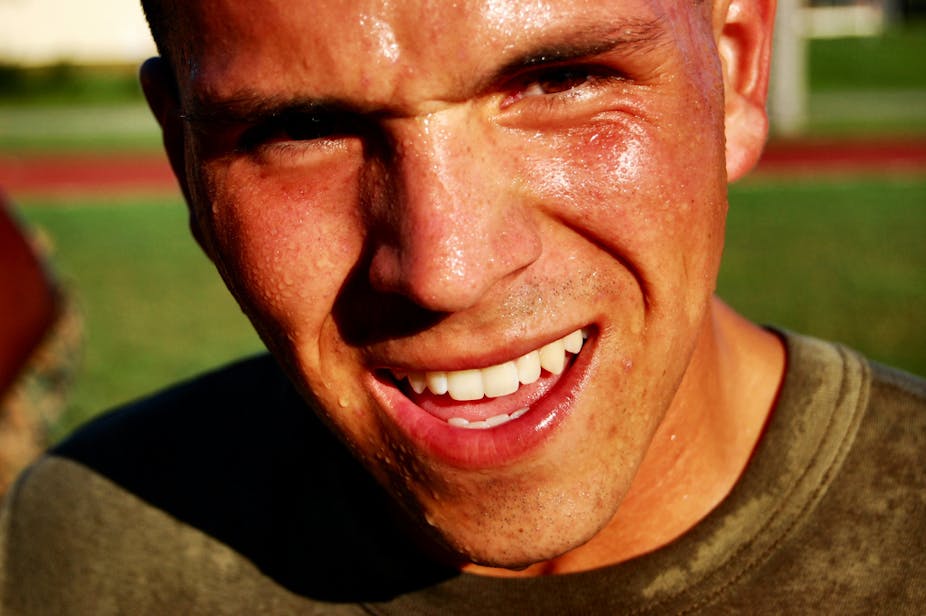Everybody sweats, some more than others. It’s a physiological reaction to heat and the body’s mechanism to regulate core temperate.
Individual sweat rates vary and are influenced by factors such as ambient temperature, humidity, air movement, exercise intensity, clothing and body size. Daily fluid loss from sweat may be as little as 100ml per day for a sedentary person in a cool climate or as much as nine litres per day for elite athletes training in hot and humid climates.
The body has two main types of sweat glands. Eccrine glands are found all over the body. These are supplied by sympathetic nerves and activated in response to heat and stress. Apocrine glands are found mainly in the armpits and groin and contribute to body odour rather than moisture.
Body odour is produced when bacteria break down the protein secreted in apocrine sweat. High salt levels in the eccrine gland sweat inhibit bacterial growth, making eccrine sweat odourless.
The human stress response, also known as the fight-or-flight response, involves secretion of adrenaline by the adrenal gland. The adrenaline released travels in the circulation to the skin and activates eccrine sweating. Many people are familiar with the sensation of sweaty palms at moments of stress or anxiety.
Deodorants
Roll-on and spray antiperspirants are sufficient for all but the most severe sweaters. The main ingredients, aluminium chloride and aluminium chlorohydrate, have stood the test of time as a safe and effective way to control underarm perspiration.

Antiperspirants can be used anywhere on the body. The aluminium reacts with the electrolytes in the sweat to form a gel plug that blocks the sweat duct. This blockage feeds back to the sweat gland and inhibits sweat secretion.
The first commercial deodorant, Mum, was developed and patented by a US inventor in 1888.
Bristol Myers bought the company in 1932 and in the late 1940s developed a roll-on applicator based on the newly invented ball-point pen. In 1952, the company began marketing the product under the name Ban Roll-On in the United States. It is still sold under the name Mum in the United Kingdom and Australia.
Long-acting high-intensity preparations containing aluminium chloride hexahydrate have become increasingly available in recent years and many heavy sweaters can gain control with these agents. Some products are sold in pharmacies over the counter, without the need for a prescription.
Hyperhidrosis
Approximately 3% of the population suffer from some form of excessive sweating, called hyperhidrosis. About half of those affected have axillary (or underarm) hyperhidrosis.
If over-the-counter products don’t give you relief, it might be time to visit a specialist. In the assessment, the dermatologist will take a history to establish the nature and severity of the sweating and the impact it is having on your life.
The specialist will examine the skin for irritation or a rash. They will also take blood tests to exclude conditions such as thyroid disease and diabetes, which can sometimes cause excessive sweating. Some antidepressants can also make sweating worse.

If you have hyperhidrosis, or excessive eccrine sweating, the dermatologists may prescribe tablets to reduce the nerve activation of sweat glands. Or they may recommend iontophoresis treatment, which uses water and a mild electrical current to deal with sweaty palms and soles.
Another option is to use Botox to paralyse the eccrine glands and stop the sweating dead. Botox is listed on the Medicare Benefits Schedule for underarm sweating in those who have tried everything else without success.
Botox is injected into the skin of the armpit superficially. While the injections are moderately uncomfortable, no local anaesthesia is required. The armpits will then remain completely dry for somewhere between six and nine months.
Botox can also be used for sweating elsewhere on the body, but without the Medicare rebate. The cost can be close to A$1,000, depending on the size of the area to be treated and the amount of Botox required.
Hyperhidrosis was traditionally treated with sympathectomy surgery, which involves cutting the nerves that trigger sweating, but this is becoming a thing of the past. While some people get good results, compensatory hyperhidrosis can cause breakout sweating in previously unaffected areas of the body. Some people also find the effects wear off over five to ten years.
Fortunately, compensatory hyperhidrosis is rare after Botox. In fact, there are few complications.
If you are concerned about excessive sweating, consult your GP, who can refer you to a specialist if required.

